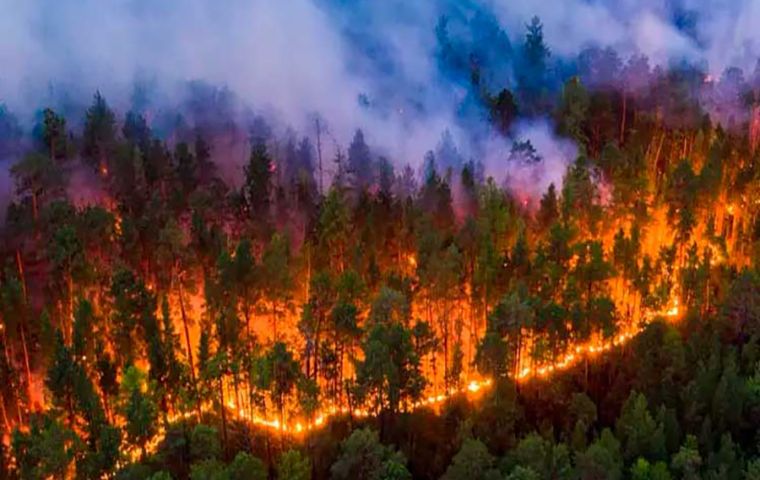MercoPress. South Atlantic News Agency
Heat wave could raise temperatures to nearly 50ºC in South America
 In Uruguay, the first days of 2022 were already marked by frightening images of fires in different regions.
In Uruguay, the first days of 2022 were already marked by frightening images of fires in different regions. An unprecedented heat wave is going through South America and some cities in Argentina, Uruguay and Paraguay have been forecast to be looking out for temperatures around 50ºC, it was reported, while 40ºC seems to have become the new normal.
Buenos Aires and Montevideo reached that mark Tuesday, while the city of San Antonio Oeste, in Argentine Patagonia, had registered 42.8ºC on Monday. For the Argentine capital it was the highest temperature since 1995. The National Weather Service (SMN) also said the city was facing its fourth hottest day in 115 years, or since records began to be archived in 1906.
According to MetSul, a meteorology company from Rio Grande do Sul in Brazil, some areas in Argentina are expected to reach between 45ºC and 47ºC, while Uruguay will face temperatures between 41ºC and 43ºC.
MetSul also forecast maximums of 41ºC and 42ºC in the coming days for the Argentina bordering city of Uruguaiana, while colder regions, such as Serra Gaúcha, are expected to endure 37ºC in Caxias do Sul and around 40ºC in the Farroupilha and Bento Gonçalves valleys.
Just like Buenos Aires and Montevideo, Porto Alegre too is to face marks around or above 40ºC, Civil Defense having already issued a warning to the population to shelter from the sun, maintain constant hydration and avoid physical exercise between 10 am and 4 pm.
The highest temperature ever recorded in Rio Grande do Sul, according to official data recorded since 1910, was 42.6ºC, in the summers of 1917, in Alegrete, and of 1943, in Jaguarão.
Farmers in southern Brazil, Uruguay and Argentina have suffered significant crop losses with a deep drought last year and the current temperatures spell further trouble for the already beleaguered producers.
In Rio Grande do Sul, 159 municipalities are already in an emergency situation due to the drought that started in November. The losses recorded so far are spread across the production of grains, fruits, vegetables and milk.
In Uruguay, the first days of 2022 were already marked by frightening images of fires in the Paysandú area, where about 37,000 hectares were burnt in the biggest fire in the country's history.
Meanwhile, Argentine authorities have been warning since last week of the possibility of a power supply crisis with power cuts in Buenos Aires and other cities in the country. This Tuesday alone, 11 neighborhoods and 700,000 users were without electricity in the capital.
According to Éder Maier, a specialist in climatology in South America and a member of the Polar and Climatic Center of the Federal University of Rio Grande do Sul (UFRGS), the current heat wave is a consequence of the mass of hot and dry air installed between Argentina and Brazil. The phenomenon is favored by the area of high atmospheric pressure that is acting over Rio Grande do Sul, raising temperatures and reducing air humidity.




Top Comments
Disclaimer & comment rulesCommenting for this story is now closed.
If you have a Facebook account, become a fan and comment on our Facebook Page!